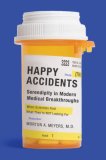Summary | Excerpt | Reviews | Beyond the Book | Readalikes | Genres & Themes | Author Bio

Critics' Opinion:
Readers' Opinion:
First Published:
Mar 2007, 408 pages
Paperback:
Dec 2008, 408 pages
 Book Reviewed by:
Book Reviewed by:
BookBrowse Review Team
Buy This Book
Creativity is a word that most people associate with the arts.
But the scientific genius that leads to great discoveries is almost always
rooted in creativity, and creativity in science shares with the arts
many of the same impulses. Common to both are the search for selfexpression,
truth, and order; an aesthetic appreciation of the universe;
a distinct viewpoint on reality; and a desire for others to see the world
as the creator sees it. The novelist Vladimir Nabokov bridged the tension
between the rational and the intuitive in his observation that
“there is no science without fancy and no art without fact.”
Among artists, the creative urge with its sometimes fevered
obsession has entered our folklore. Legend has it that one day, when Sir
Walter Scott was out hunting, a sentence he had been trying to compose
all morning suddenly leaped into his head. Before it could fade,
he shot a crow, plucked off one of its feathers, sharpened the point,
dipped it in the bird’s own blood, and recorded the sentence. In the
twentieth century, Henri Matisse, bedridden in his villa near Nice during
his recovery from abdominal surgery, could not restrain himself
from using a bamboo stick with chalk at its tip to draw on his bedroom
wall. Among scientists, the creative urge is no less compelling.

Henri Matisse, ca. 1950. Photo by Walter Carone.
Creative people are open-minded and flexible in the face of unusual
experiences. They are alert to the oddity of unexpected juxtapositions
and can recognize a possibility even when it is out of context. In
his massive work The Act of Creation, Arthur Koestler proposes that
bold insights are produced by juxtaposing items that normally reside
in different intellectual compartments, a process he terms “bisociation.”
In many scientific discoveries, he asserts, “the real achievement
is seeing an analogy where no one saw one before.”
In the late 1940s the biologist Aser Rothstein saw such an analogy.
He was working at a unit of the then-secret Manhattan Project established
at the University of Rochester. At that time, the cell membrane
was basically an abstract notion, and the leading concept simply regarded
diffusion across it as being of a passive nature. Rothstein was
studying the toxic action of uranium salts on cells. Laboratory data were
coming out well and reproducibly until, suddenly, everything went
wrong. There was no progress, and no two results were the same.
One day, when Rothstein walked into his lab, he noticed a box of
detergent that was used in the lab to clean glassware. On the box, surrounded
by a flashy red star, were the words “New Improved Dreft.”
Comparing its label to that of an old box of Dreft, Rothstein saw that
the new version contained an added ingredient — a water softener. As
it turned out, this softener coated glass tenaciously and chemically
bound the material Rothstein was studying (uranium ions) to the surface
of the glass. His creative mind then made an extraordinary leap.
He wondered about a possible analogy: If there is binding on the surface
of glass, could there be binding on the surface of a cell?
Seizing upon this capability of the chemical in the water softener,
he went on to prove that there are binding sites on the cell surface as
well. Fortune had provided him with a contaminant similar to the natural
enzymes involved in transport across the cell membrane. But Fortune
might have come calling in vain if not for Rothstein’s ability to
draw the essential analogy. Some ten years before the cell membrane
could actually be seen with the development of electron microscopy,
Rothstein’s “accidental” discovery enabled him to show that it was a
metabolically active structure containing enzymes critical in transport
mechanisms..
Excerpted from Happy Accidents by Morton Meyers, M.D. Copyright © 2007 by Morton Meyers, M.D. Excerpted by permission of Arcade Publishing. All rights reserved. No part of this excerpt may be reproduced or reprinted without permission in writing from the publisher.





The House on Biscayne Bay
by Chanel Cleeton
As death stalks a gothic mansion in Miami, the lives of two women intertwine as the past and present collide.

The Flower Sisters
by Michelle Collins Anderson
From the new Fannie Flagg of the Ozarks, a richly-woven story of family, forgiveness, and reinvention.

The Funeral Cryer by Wenyan Lu
Debut novelist Wenyan Lu brings us this witty yet profound story about one woman's midlife reawakening in contemporary rural China.
Your guide toexceptional books
BookBrowse seeks out and recommends the best in contemporary fiction and nonfiction—books that not only engage and entertain but also deepen our understanding of ourselves and the world around us.